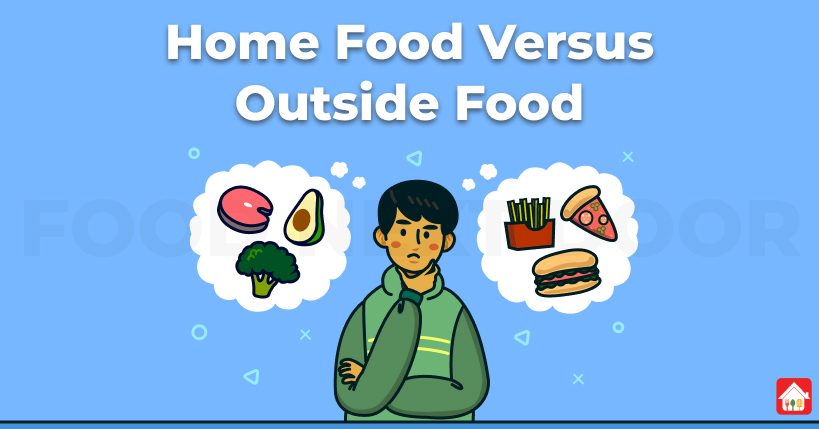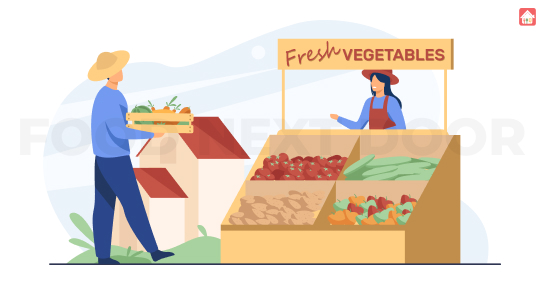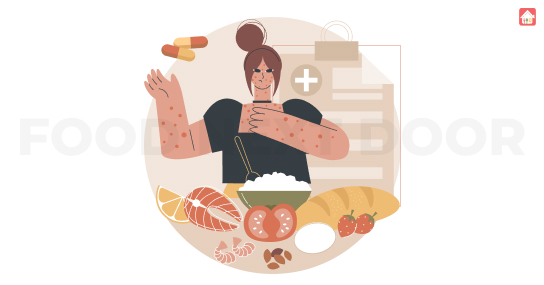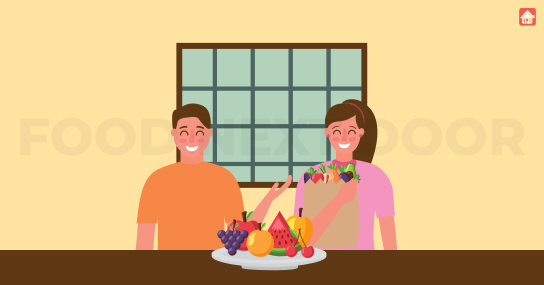Table of Contents
India has a lively food culture, with an unending array of delectable dishes to sample from each state. It’s no surprise that many of us are looking at several Mobile Food Delivery applications every day to try something new. This food craze spawned a massive ecosystem of commercial kitchens (dubbed “Cloud Kitchens” by some) dedicated solely to delivery, allowing them to save money on rentals by eliminating sitting and dining arrangements.
According to the International Journal of Research, revenue from online food delivery in India is estimated to be around a billion dollars, with double-digit percentage growth. With about 200 million users purchasing food online in India, the online food delivery industry is rapidly expanding. The ease with which people can order and eat meals from outside has resulted in a slew of illnesses. Street food should be avoided as much as possible, according to medical advice. Food produced outside is usually unhealthy, and it is frequently prepared in filthy kitchens. The majority of outside food ingredients are processed and include dangerous additives. Obesity and fatal diseases like Heart Attacks and Cancer are linked to eating food from outside sources, according to a medical study.
You may believe that getting cheap food on your way home from work is easier and faster because of your hectic schedule. In any event, there are several fundamental drawbacks to this lodging. Handcrafted suppers are generally more beneficial than a takeaway, according to research. By preparing your meals with new, healthy ingredients, you can spare yourself unwanted calories, carbohydrates, saturated fat, and sodium, thereby lowering your risk of hypertension, Type 2 diabetes, and heart disease.
Advantages of Home Food
Our cultural heritage is intrinsically linked to home cooking. Having home-cooked meals with family at home is one of life’s greatest pleasures. It’s incredibly satisfying to share home-cooked meals with family and friends. Around the dining table, which is adorned with the finest homemade delicacies, we have had some of the best discussions and most fun. Home cooking has many advantages, as we all know: it’s delicious, it’s healthier, it’s fresh, and, sure, it’s inexpensive. At home, we have control over how much fat, sugar, and salt we put in our food. We can also keep track of how much food we eat. In other words, you know what you’re consuming and you’re feeding your body what it requires. Obesity rates are lower in countries where people spend more time preparing food at home, according to research. Our children learn healthy eating habits through cooking at home. It is also instructive and enhances their nutritional awareness. It aids in the development of lifelong abilities that they will hopefully pass on to their children. It’s a lot of fun to eat at home, and it’s also a lot of fun to eat it. All Fresh meals require a little time to prepare, but the result is a Heavenly Experience, as opposed to refrigerated food with preservatives delivered in minutes by most Food delivery Apps.
Every doctor agrees that home cooking is the only healthy diet since it gives the body the essential nutrients it needs to be healthy. Ghar Ka Khana is similar to medicine in that it heals our bodies. Everyone knows that home-cooked food is the healthiest for our stomachs, but our long work hours, boredom with cooking, and lack of culinary abilities lead us to buy food online.
Cooked-at-home meals are good for the environment.
Cooking at home allows us to select local foods such as vegetables from farmers markets and grass-fed beef while reducing needless packaging.
Physiology
After encountering physiological challenges, people frequently need to start preparing their meals —
Those who are diabetic or prediabetic require a low-sugar diet since processed foods generally exceed their dietary sugar needs. As a result, cooking at home is the most reliable strategy to cut down on needlessly added sugars in your diet.
Restaurants that cater to gluten-free diets and celiacs may be tough to come by. Rice, quinoa, almond flour, and cornbreads are examples of grains that are used instead of wheat in these diets.
This flour is used as a thickening in soups and sauces, as well as breading for pan-fried meals, in restaurants.
Low sodium diets are recommended for people who are at risk for heart disease and high blood pressure. People who are used to eating processed foods also have a hard time because sodium is used to enhance flavour while also acting as a preservative in these goods. To reduce your salt intake, the greatest thing you can do is prepare food at home.
Location
The farmer’s market, to the best of our knowledge, is an excellent source of less processed foods. On the other side, it helps farmers and small business owners in your area while reducing the carbon footprint of food transportation.
Another incentive to consume home-cooked food is because there may not be as many healthy eating options in small towns and rural locations. Farm-to-table restaurants have been proposed in major cities.
Despite this, numerous eateries provide chemically processed, preservative-laden, high-sodium cuisine.
What Is the Nutritional Difference?
When comparing the nutritional value of outside food vs home-cooked food, you’ll find that the dinners you prepare yourself are usually far more beneficial. Quick foods and café dinners may be heavy in salt, inhibiting cholesterol and calories by blocking the supply route. You may manage the ingredients by preparing your food, substituting sugar-free or low-sodium options, and including extra veggies and whole grains. Choosing healthy fats for your diet will strengthen your heart.
You can also manage the portions you serve – many restaurants’ larger-than-normal serving sizes might lead to overeating. Instead of ordering a 12-ounce steak at a restaurant, get a 3- or 4-ounce portion of meat and fill the rest of your plate with firm vegetables to avoid saturated fats and increase fibre intake. Instead of the sugar-laden pastries that tempt you at cafés, serve a new organic product or natural product compote to help you achieve your daily requirements.
Another distinction between outside and homemade foods is salt level. Although it is recommended to use less salt when seasoning meals at home, cafés and low-cost eateries use generous amounts to enhance flavours. Salt is also found in food additives and added compounds. You can bet the sodium content of the baked products, doughnuts, or bread you buy is high, even if they don’t taste salty.
Children’s Weight
Whether you go out or bring cheap food home, those quick meals could be harming your children’s health. Corpulence in children is a growing public health concern, and it carries the risk of developing coronary artery disease and Type 2 diabetes later in life.
Kids who never ate takeaway dinners were compared to those who ate at least one takeaway dinner per week in a study involving 85 schools. The findings, published in Archives of Disease in Childhood in 2018, showed that eating takeout was linked to higher fatty and saturated fat intake, as well as reduced protein and vitamin intake. In addition, those who ate takeout had higher total and LDL cholesterol levels, as well as a higher BMI.
The study concluded that the consumption of takeaway dinners in children could have long-term consequences for weight and the risk of cardiovascular sickness due to increased muscle mass vs fat and poor quality eating habits.
Allergies and Sensitivities to Food
Several people have hypersensitive reactions to various foods and flavours. Even a small amount of a food allergen might cause an allergic reaction.
If you have food sensitivities or hypersensitivities, eating restaurant food could pose a problem. In any case, if you have a serious ailment like celiac disease, demanding gluten-free dinners may now be a poor idea if the kitchen’s cooking methods allow for cross-contamination. It’s tough to tell if your café supper is truly nut-free or if it contains fish.
Cooking at home has the advantage of ensuring that your ingredients are free of toxins and are immaculate. When you’re in charge of your kitchen, you can reduce the possibility of hostile reactions.
Weight Loss
Aside from the fact that home-cooked dinners are more cost-effective, a single serving at a fast-food restaurant can cost you all of the recommended calories for the day. Handcrafted dinners typically have fewer calories, which is beneficial if you’re trying to lose weight.
Healthy Fast-Food Alternatives
When you don’t have time to cook a meal or put together a lunch and inexpensive food is your only other option, look for the most cost-effective options. This means foods with a good balance of macronutrients, especially protein, and low levels of sugar, salt, and trans fat.
Getting a takeout portion of mixed greens is usually a good idea.
Conclusion
Great news for those who are unable to cook at home due to a variety of factors yet do not want to sacrifice their health. Food next door is the best mobile app for homey food prepared by home master chefs with a long history of patronising certain age-old traditions and cuisines passed down through generations. Every Home Chef on Food Next Door has been hand-picked for its outstanding Culinary Skills and impeccable Cleanliness. Every Home Chef’s kitchen has been visited by the Food Next Door team, who are convinced by their principles, practices, and love for cooking and serving people. Food next door is an all-in-one food delivery app that allows you to order cakes, biryani, and pizza online.







